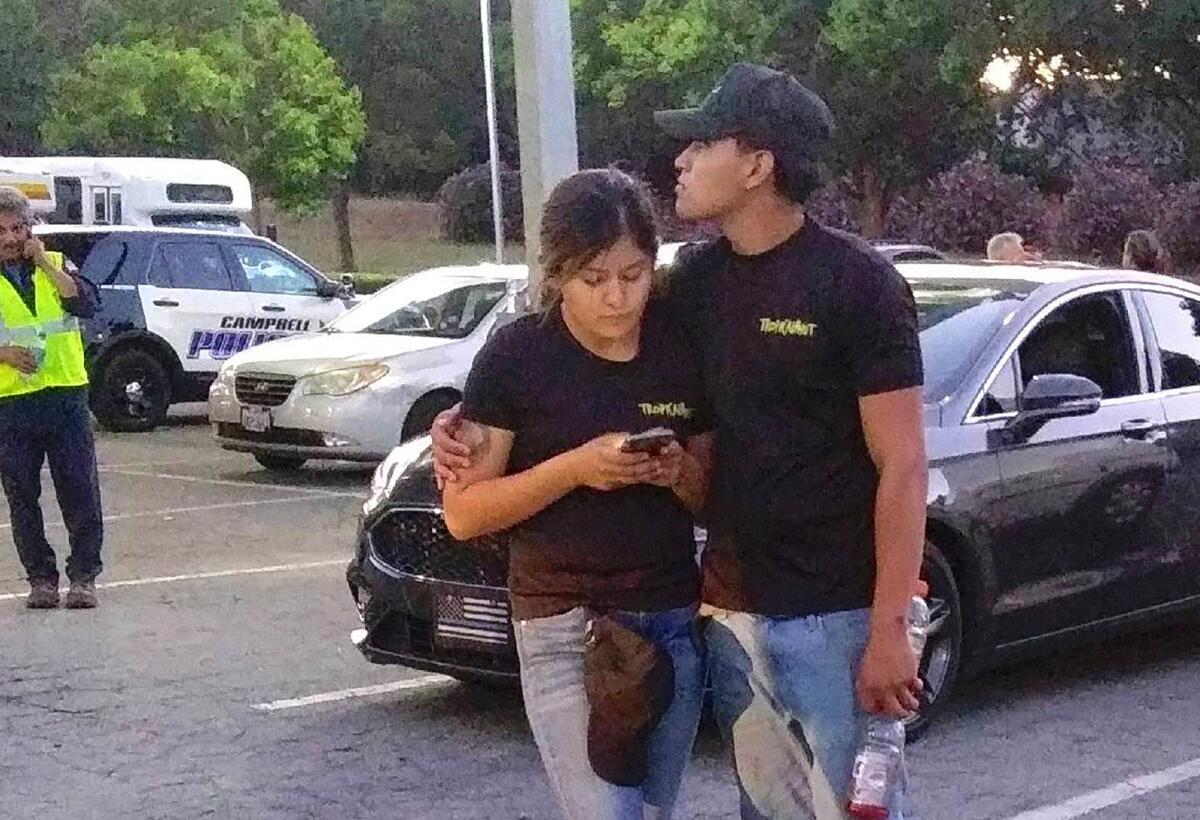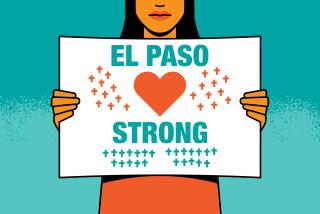3 mass shootings in less than a week, and Trump gets some blame in Gilroy

- Share via
GILROY, Calif. — The streets here were eerily quiet Sunday.
It had been a week since a gunman had shot and killed three people at the popular Gilroy Garlic Festival. Parks were empty, church parking lots were barren, and many businesses were deserted. Outside, the only people noticeable were families who had gathered for a girls softball game at Gilroy High School, next to the blocked-off entrance to Christmas Hill Park, where the Gilroy Garlic Festival took place.
A week ago, the world’s eyes were on this city, the scene of the latest mass shooting in America. But this weekend, two other cities have taken that grim mantle, first El Paso, where a gunman killed 20 people at a Walmart, and Dayton, Ohio, where a gunman opened fire in a popular nightlife area, killing nine.
But Tacos Ameca, a Mexican restaurant, was bustling at 10 a.m. “Homemade tortillas daily,” read a green, red and white sign on the corner of Monterey Road and East 10th Street.
Inside, rancheras played on the radio and the cooks whistled along while they flipped meat on a flattop grill. In the corner of the the restaurant, two women sat together eating an early lunch — birria tacos.
They worked as cooks and cashiers at the restaurant and wore their hairnets during their brief lunch break. They had been scared to venture far from work or their homes in the week after the shooting, they said.
“You can’t go outside anymore,” said Margarita Armijo, 53. “We were thinking of going to San Diego this weekend, but we were worried that something would happen.”
Gilroy no longer felt the same, Armijo said. She was worried that in the last two years President Trump’s comments about the Latino community, and other communities, had encouraged people to take violent action.
Armijo is from Puebla, Mexico, but has lived in the United States since she was 17 years old. “I think that the president has a lot to do with this,” Armijo said, referring to the shooting incidents in Gilroy and El Paso, “because of how racist he is.” Her friend, Adelina Ruiz, chimed in. “He incites people to do bad things,” Ruiz, 30, said. “It becomes a chain reaction.”
Ruiz is from Oaxaca and has lived in the United States for five years. She’s been happy here but has noticed more animosity toward Latinos in recent months.
“Here, while I was working as a cashier one time, people came in and asked me why I was speaking Spanish, they told me I should be speaking English,” Ruiz said. “At Starbucks that happened to me too. … They don’t attend to you the same way because you don’t speak English.”
These incidents both happened in the last few months, she said. But Ruiz laughed it off, questioning why people would come to a Mexican taco restaurant if they expected everyone to speak English. She found that ridiculous, she said.
Over at St. Mary Parish, Gerardo Ortiz sat in a wheelchair, parked in his usual spot outside the Gilroy church. Passersby greeted him in English and Spanish as Mass began. There weren’t many people in attendance. Next to him, some stopped briefly, kneeling to pray at an altar of the Virgin Mary, and to light a candle or two.
Ortiz, 73, said he had experienced racism all his life, back in Puebla, Mexico, where he lived more than 35 years ago, and here in the United States. But he too thinks the recent escalation in gun violence can be attributed to the influence of President Trump.“This president provokes more violence. He shouldn’t have that vocabulary,” Ortiz said in Spanish. “If he sets that example, other people are going to follow what he says and does.” As Ortiz spoke, the sounds of church hymns traveled outside the parish door.
Across the street, the owner of a party supplies store, hung up three piñatas outside the storefront. Leon, who did not want to give his last name due to concerns about his legal status, has lived in the United States for about 40 years and has owned the store in Gilroy for seven.
He said the Latino community in Gilroy, particularly the Mexican community, was very close — and that he and his family were deeply saddened by reports that the shooter who opened fire in El Paso might have been fueled by hate toward Latinos.
“The Latino community is hurting,” Leon said. And for the people of Gilroy, it was personal. “It’s not normal to not see anyone out on the streets today,” he said as he stood in the narrow hallway of his store, the ceiling adorned with piñatas displaying every Disney character imaginable, and the walls lined with white first communion and baptism dresses. “It looks like everyone prefers to be at home.” Sales have gone down sharply in the last week, he said.
People often rent chairs and tables from his store for the Gilroy Garlic Festival, though he has never attended. Since the election of President Trump, and especially since the announcement of the possibility of large-scale ICE raids several weeks ago, Leon’s children have been worried that both their parents might be deported, he said.
“They are scared that their mother isn’t going to come back home,” Leon said. And he feels that concern, too. “That’s the fear: that you are going to leave your house and never come back.” If he is sent back to Mexico, he will return to his home state of Querétaro.
If that happens, Leon is confident that his six children, the youngest of whom is 16, will be able to carry on the business and succeed in their lives without him physically present, he said. But he is hoping that the violence will subsid, and that his community begins to heal from the traumatic events of the past week.
Santino William Legan, 19, opened fire at Gilroy’s popular food festival Sunday evening,
He killed three people, two of them children: 6-year-old Stephen Romero; Keyla Salazar, 13; and Trevor Irby, 25.
Law enforcement authorities have not identified a motive. The FBI seized from Legan’s residence what a law enforcement source described as extremist materials , but John F. Bennett, special agent in charge of the bureau’s San Francisco office, pushed back on reports that Legan was motivated by extremist or white supremacist beliefs. Written materials taken from Legan’s residence in Nevada ran the ideological gamut, Bennett said.
FBI profilers are interviewing Legan’s relatives and associates, reviewing his presence on online platforms and combing through materials seized from a Nevada residence, including several hard drives, a computer tower, books and a letter from a relative, according to a receipt of a search warrant released by Nevada authorities.
Bennett said Thursday there was no indication Legan targeted festival attendees of a particular race.
More to Read
Sign up for Essential California
The most important California stories and recommendations in your inbox every morning.
You may occasionally receive promotional content from the Los Angeles Times.










